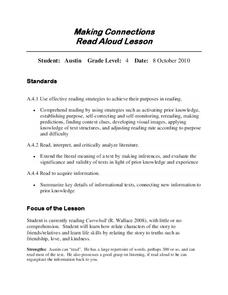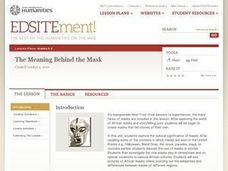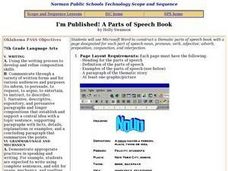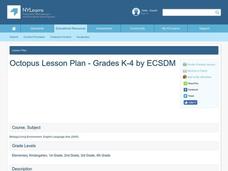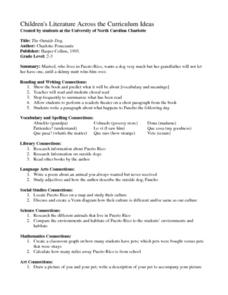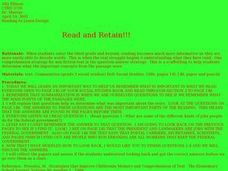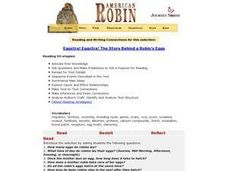Curated OER
Storybook Theater
Tell a story visually using this resource. Learners design a storybook theater by creating a book and painting watercolor pictures describing scenes from the story. This is a creative means to have your class practice summarizing skills.
Curated OER
Making Connections
Fourth graders investigate visual imagery to aid reading comprehension. In this reading strategies lesson, 4th graders discover how visual imagery helps in comprehending a story. Students use a reader's notebook to record connections.
Curated OER
The Meaning Behind the Mask
Students explore the world of African masks and storytelling. They create masks that tell stories of their own.
Curated OER
I'm Published! A Parts of Speech Book
Reinforce the importance of the writing process with this publication lesson. Elementary and middle schoolers compose a parts of speech book which includes one page each for nouns, pronouns, verbs, adjectives, adverbs, prepositions,...
Curated OER
Octopus Lesson Plan
Children explore the life of an octopus. They listen to a story, answer prediction questions and share their prior knowledge of animals. Students observe the defense mechanism of the octopus. They create an imaginary defense mechanism...
Curated OER
The Outside Dog
Learners observe the book, "The Outside Dog," and predict the events of the story. At the conclusion of the story, students act out various paragraphs from the book and write about specified characters. Additional cross-curriculum...
Shmoop
ELA.CCSS.ELA-Literacy.RL.11-12.2
There is nothing more frustrating than discussing theme in literature, and now the Common Core requires that your learners determine two or more, and discuss the development of it throughout the text. This is crazy, but manageable with...
Curated OER
Beginning to Read
Students explore various books read by their classmates outside of school. After reading books of their choice, the class creates a bulletin board summarizing their main ideas of the book and their opinion of the book using Flat Stanley.
Curated OER
Journey to Topaz: KWHL Strategy
Japanese Internment and World war II are the focus of a KWHL strategy used to scaffold for a reading of Journey to Topaz, Yoshiko Uchida's story of 11-year-old Yuki Sakane and her family. Complete directions for the activity...
Curated OER
Read and Retain
Third graders practice strategies for aiding in their comprehension of material they read. Through guided practice, they read a selected piece of text and answer questions pertaining to what they have read. They practice looking back in...
Curated OER
Understanding Narrative Poetry
In this poetry worksheet, students learn about narrative poetry. They then answer 7 questions about one of the poems they read, practice writing their own narrative poem, and complete a research project using the internet. The answers...
Curated OER
5 W Questions
Second graders practice asking the 5 W questions by reading a Boxcar Children book. In this journalism instructional activity, 2nd graders read a single story from the Boxcar Children series and answer the 5 W's about each...
Read Works
Retelling A Life
Use comic strip format to help organize and sequence events in a story. The lesson here focuses on The Story of Jackie Robinson: Bravest Man in Baseball; however, this strategy could be used for summarizing any text. Pupils must choose...
Curated OER
JIP: His Story
Students are provided with a three-column chart about a fictional character named Jip: looks, personality, and situation. After chapter 1 and chapter 2, students make notes on the charts and share that information with one other. They...
Curated OER
The Gray Wolf Story Pyramid
Students explore comprehension and understanding of what they read. They practice using the correct spelling for frequently used sight words and uncommon words. Students apply the correct principles of grammar. They read the article Gray...
Curated OER
American Robin: Eggstra! Eggstra! The Story Behind a Robin's Eggs
Students answer questions about robin's eggs. They read about robins, then mark up text for unfamiliar words.
Curated OER
Literary Analysis: Summary vs. Analysis
What is the difference between summary writing and literary analysis? A 16-slide presentation offers some basic requirements for both types of writing and helps readers identify each based on keywords used in both types of writing....
Tell City Schools
The Cay
Support your instruction of The Cay by Theodore Taylor with this extensive unit of materials. Provided here are prereading activities, worksheets and discussion questions for the entire book, and reading quizzes that you can use to check...
Super Teacher Worksheets
Literature Circle Packet
Looking to set up literature circles in your class? Use these materials to support pupils when they meet in groups. Pupils take on various roles over the course of reading and meet with their groups to share the work they have done on...
Teach It Primary
The Pied Piper of Hamelin
Six tasks make up a lesson plan designed to reinforce comprehension and language skills using the poem "The Pied Piper" by Robert Browing. Scholars discuss and define unknown words, identify adjectives and onomatopoeia, review...
Curated OER
Meaty Words
Headlines from newspapers launch a discussion of image-rich, meaty words. Just as headline writers choose vivid vocabulary to attract readers, young writers develop headlines that capture the essence of a passage from a book they are...
Curated OER
Writing a Summary
Skim, reread, and then take notes. The step-by-step procedure outlined in this resource can be used to help pupils write a summary of a reading passage. Using their notes, class members then draft a summary focusing on the main idea and...
Curated OER
Scrolling Along
Young scholars summarize the important parts of a story, identify the characters, and decide how to picture several scenes that describe the setting and action. They graphically represent the important elements of the story on a fabric...
NASA
NASA
Everything you have ever wanted to know about our solar system, space exploration, and more can be found here. Be prepared to clear your schedule; you will be sucked into the app like a star into a black hole.



